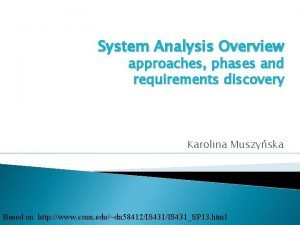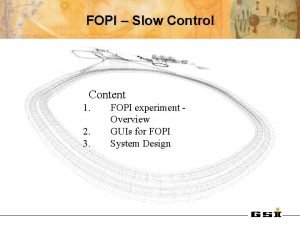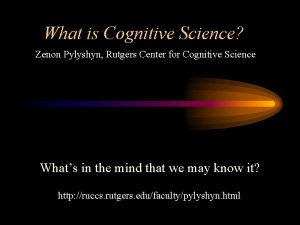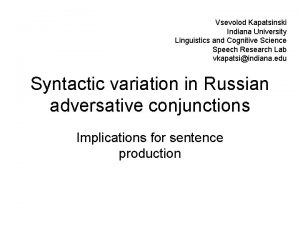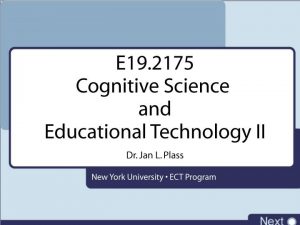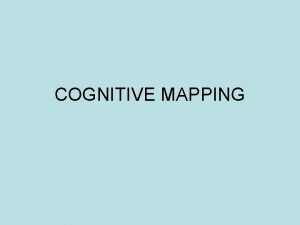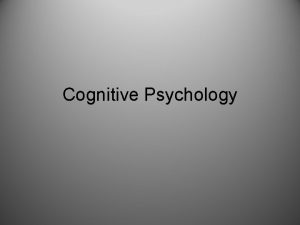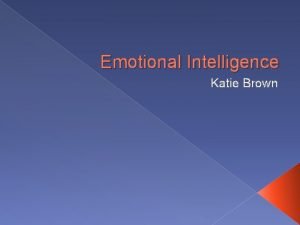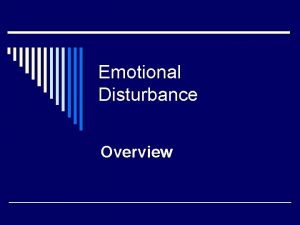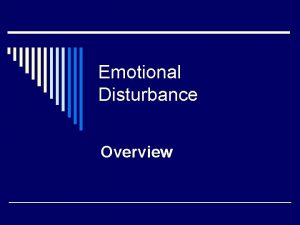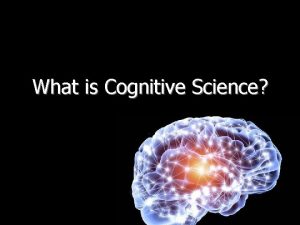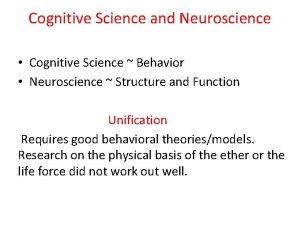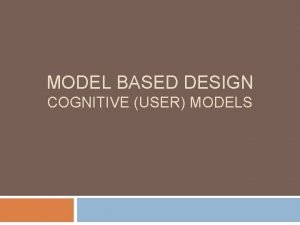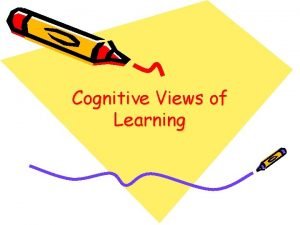Cognitive Science Overview Emotional Design Cognitive Science Emotional
















- Slides: 16


Cognitive Science Overview • Emotional Design

Cognitive Science Emotional Design�� Emotions and Moods • Psychiatry: "mood" routinely used to denote states of happiness and sadness and their extremes • Emotions: person's mental state of being, normally based in or tied to the person's internal (physical) and external (social) sensory feeling

Cognitive Science Emotional Design�� Seven emotions • fear (or terror, shock, phobia) • anger (or rage, which can be directed to the self or others) • sorrow (or sadness, or grief or depression, which some people think of a separate emotionムsee depression) • joy (happiness, glee, gladness). • disgust・acceptance・anticipation・surprise Source: Wikipedia

Cognitive Science Observation Task Scenario I will demonstrate a number of sites/materials. Please take notes on the following observations: · List the strongest emotions you experienced. · What was your general emotional response to the site? Elaborate why. Later: · How can the site be described in terms of the three levels of processing (visceral, behavioral, reflective?

Cognitive Science Emotional Design�� Impact on Learning • Emotions impact cognition • Mood-dependant retrieval • Mood-congruent processing

Cognitive Science Emotional Design�� Mood-dependent retrieval

Cognitive Science Emotional Design�� Mood-dependent retrieval

Cognitive Science Emotional Design�� Mood-congruent processing

Cognitive Science Emotional Design Model�� Astleitner (2000) FEASP Model

Cognitive Science Emotional Design�� Levels of Information Processing • Visceral Level • Behavioral Level • Reflective Level

Cognitive Science Emotional Design�� Levels of Information Processing • Visceral Level –automatic, ‘prewired, ’ genetically programmed –response based on recognizing sensory information –incapable of reasoning –uses pattern matching: * positive affect based on food, warmth, protection * negative affect based on unknowns, danger indicators –but: this biological mechanism is only resulting in predispositions –Product characteristics: appearance –Learning environments: _________ from: Norman (2004)

Cognitive Science Emotional Design�� Levels of Information Processing • Behavioral Level –controls human action and behavior –not conscious -- automatic, routine operations –actions can be enhanced or inhibited by reflective level –can enhance or inhibit visceral level –Product characteristics: pleasure and effectiveness of use –Learning environments: _________ from: Norman (2004)

Cognitive Science Emotional Design�� Levels of Information Processing • Reflective Level –contemplative part of brain –not bound to the immediate feelings - includes past and future –Most vulnerable to variability through culture, experience, education, individual differences –can override other levels –Product characteristics: self-image, personal satisfaction, memory –Learning environments: _________ from: Norman (2004)

Cognitive Science Group Discussion Scenario Based on the games reviewed so far, consider: · What, if anything, can games teach us about the design of learning environments? · How do games evoke emotions? · Do certain types of games represent certain aspects of some of theoretical frameworks we have discussed? · Sort Gee’s principles based on a theoretical approach you devise, using theories discussed to date.

Cognitive Science Group Work Scenario Review the one of the Games-To-Teach frameworks. [http: //www. educationarcade. org/gtt/proto. html] Discuss the following questions · Is the approach taken effective for the content and audience specified? · Does the approach appear to be based on a theoretical framework? · What emotional impact do you expect this game to have on learners?
 Cognitive and non cognitive religious language
Cognitive and non cognitive religious language System analysis
System analysis System design overview
System design overview Favourite subject
Favourite subject Rutgers cognitive science
Rutgers cognitive science Hubungan sains dengan kognitif
Hubungan sains dengan kognitif Vsevolod kapatsinski
Vsevolod kapatsinski Overview of www
Overview of www Maximo overview
Maximo overview Universal modelling language
Universal modelling language Uml overview
Uml overview Vertical retail
Vertical retail Figure 12-1 provides an overview of the lymphatic vessels
Figure 12-1 provides an overview of the lymphatic vessels Overview of the major systemic arteries
Overview of the major systemic arteries Texas public school finance overview
Texas public school finance overview Walmart company overview
Walmart company overview Stylistic overview
Stylistic overview

